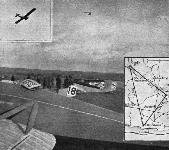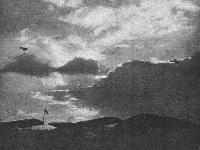
Flight, October 1923
THE AVRO LIGHT MONOPLANE, TYPE 560
700 c.c. Blackburne Engine.
THE Avro type 560, built for the competitions at Lympne, is a cantilever monoplane which, although in external appearance following the usual practice, has several unusual constructional features.
The fuselage is of somewhat similar construction to that employed in the biplane, although the external shape is rather different. The four longerons are of spruce with spruce struts running diagonally to form a Warren girder, the struts being attached to the longerons by means of three-ply "biscuits" glued and nailed in position. As in the case of the biplane fuselage, the covering is fabric throughout, longitudinal stringers keeping this clear of the struts, etc. Except for the fact that it is practically flat-sided and with flat deck and bottom, the fuselage of the Avro monoplane is of very good streamline form, and should offer very little resistance.
The monoplane wing has a pronounced taper both in chord and thickness, and is built in two halves. At the root the wing spars project a considerable distance beyond the inner rib, and fit into openings in the fuselage, where they are bolted together by means of special joint plates to form a continuous girder. The wing section used is of the bi-convex type, somewhat similar to some of the American sections described in FLIGHT of May 24, 1923. The spars are built-up box-sections, with flanges of solid spruce and walls of double diagonal spruce skins. This form of construction has been found to give an extremely rigid spar. The ribs have T-section spruce flanges tied together by means of corrugated Duralumin struts and ties. The drag bracing is formed of spruce struts and ties arranged in the form of a Warren girder and attached to the spare by means of three-ply "biscuits." The wing covering is of special light linen fabric, doped with Titanine glider dope.
The tail plane is made in two parts, which fit into suitable attachments inside the rear end of the fuselage, the two halves of the tail being fastened together so as to form a continuous member, and no external bracing is required. It is quite evident that considerable care has been taken in designing the tail unit so as to make it offer as little resistance as possible. The elevators are of the unbalanced type, hinged to the rear spar of the fixed tail plane. The rudder is of the balanced type, with a strong box-section main spar and spruce ribs. The ailerons and elevators are operated by a walnut joy-stick mounted on a universal joint at its lower end. The aileron control is by means of cables, but the elevators are operated by a long push-and-pull rod. As in the biplane, the rudder is operated by means of pedals.
The 700 c.c. Blackburne engine is mounted on an engine plate of the simplest possible form, i.e., a flat plate of 8 gauge Duralumin, to which the engine is bolted direct by the horizontal bolts through the lugs on the crank-case. Direct drive is employed, a ball thrust bearing being housed in a cage on the front end of the crank-case. The petrol tank is mounted just under the deck of the fuselage, immediately ahead of the front spar, and a specially long induction pipe has been fitted so as to give direct gravity feed to the carburettor.
The undercarriage is of very simple form, and consists of two light wooden wheels mounted on a steel tube axle. This axle is supported from the fuselage by two struts on each side. These struts are placed some considerable distance apart, so as to provide space for the rubber shock absorbers, which, with the rest of the struts, are streamlined by covering the space between the struts with metal over the lower portion and three-ply over the upper. The struts are braced laterally by short tubes running diagonally to the centre of the fuselage.
The pilot's cockpit is arranged between the front and rear spars of the wing, and an interesting feature is that the airspeed indicator is mounted in the root of the wing, so that when the machine is dismantled for transport the instrument is removed with the wing without the necessity for breaking the connections. The tail skid is in the form of a bent steel tube mounted in vertical bearings, and the landing shocks are taken by a coil spring.
The main characteristics of the Avro monoplane type 560 are as follows: Length, o.a., 21 ft.; span, 36 ft.; maximum chord, 5 ft. 4 1/2 ins.; minimum chord, 3 ft.; wing area, 138 sq. ft. The weight of machine empty is 285 lbs., and it will carry a load of 180 to 200 lbs. The wing loading is 3-4 lbs. per sq. ft., and the power loading 23-5 lbs, per h.p., with the engine developing 20 h.p. at 3,200 r.p.m.
- Flight, October 1923
THE AVRO LIGHT MONOPLANE, TYPE 560
Фотографии
-
Aeroplane Monthly 1984-08 / R.Riding - Avro 560 /British pre-war ultralights/ (41)
Регистрационный номер: J7322 [13] AT LYMPNE: No. 6, the Avro monoplane, 700 c.c. Blackburne engine, on the ground and in flight. This machine flies remarkably smoothly.
The Avro 560 at Lympne in October 1923. The pilot's view sideways must have been restricted somewhat by the wings, though forward vision was fairly good.
The Avro ultra-light monoplane (700 c.c. vee-twin Blackburne) on which Bert Hinkler covered 1,000 miles in the Lympne week of 1923. -
Aeroplane Monthly 1984-08 / R.Riding - Avro 560 /British pre-war ultralights/ (41)
Регистрационный номер: J7322 [13] Bert Hinkler standing in the cockpit of the Avro 560, possibly at Hamble
-
Aeroplane Monthly 1984-08 / R.Riding - Avro 560 /British pre-war ultralights/ (41)
Регистрационный номер: J7322 [13] The same aircraft photographed at Lympne.
-
Aeroplane Monthly 1984-08 / R.Riding - Avro 560 /British pre-war ultralights/ (41)
Регистрационный номер: J7322 [13] AT LYMPNE: No. 6, the Avro monoplane, 700 c.c. Blackburne engine, in flight. This machine flies remarkably smoothly.
A rare flying shot of the Avro 560, taken at the Lympne trials in October 1923 with Hinkler flying. On the first day of the competition the Avro completed 74 laps of the 12 1/2 mile course. -
Flight 1926-09 / Flight
Регистрационный номер: J7322 [13] 1,000 MILES AROUND LYMPNE: Mr. Bert Hinkler in his Avro monoplane, 700 c.c. Blackburne engine, at the completion of his 80 laps of the course. Inset, the machine crossing the finishing line at the end of the 80th lap. During the whole week Hinkler did not have a single forced landing.
-
Aeroplane Monthly 1984-08 / R.Riding - Avro 560 /British pre-war ultralights/ (41)
Регистрационный номер: J7322 [13] H. J. "Bert" Hinkler sitting in the Avro 560 after completing 80 laps of the 121 mile course at Lympne in October 1923. Throughout the entire week Hinkler did not make one single forced landing, which says much for the reliability of the 698 c.c. Blackburne Tomtit engine.
-
Flight 1924-09 / Flight
Регистрационный номер: J7322 [13] REMINISCENCES OF LAST YEAR'S LYMPNE COMPETITIONS: The picture shows Hinkler flying the Avro monoplane on which he covered a distance of 1,000 miles during the week, while inset is the A.N.E.C. monoplane on which James tied with Longton.
-
Flight 1923-11 / Flight
Регистрационный номер: J7322 [13] EVENING AT CROYDON DEMONSTRATION: On the left, in the air, is seen the Vickers "Viget" light aeroplane and on the right the Avro light monoplane.
Другие самолёты на фотографии: Vickers Viget - Великобритания - 1923
-
Aeroplane Monthly 1984-08 / R.Riding - Avro 560 /British pre-war ultralights/ (41)
Регистрационный номер: J7322 [13] The Avro 560 after modification for Air Ministry trials at RAF Martlesham Heath in 1924. A new inverted Tomtit engine has been installed and a conventional strutted undercarriage with wheels from one of the Avro 558s has been fitted. The aircraft was presumably finished in silver and painted in standard RAF markings of the period.
-
Flight 1923-10 / Flight
Регистрационный номер: J7322 [13] The Avro light monoplane: View of the fuselage in skeleton.
-
Aeroplane Monthly 1984-08 / R.Riding - Avro 560 /British pre-war ultralights/ (41)
Регистрационный номер: J7322 [13] The uncovered fuselage of the Avro 560, showing the aerofoil shape. Note the solid wooden wheels and the simple method of attaching the engine to the nose. The inset photograph shows the bi-convex wing section and the airspeed indicator located inside the wing.
-
Flight 1923-10 / Flight
Регистрационный номер: J7322 [13] The Avro light monoplane: End view of a wing, showing bi-convex section used. The airspeed indicator is mounted inside the wing so that the pipes need not be broken when dismantling the machine.
-
Flight 1923-10 / Flight
Регистрационный номер: J7322 [13] The Avro light monoplane: View of engine mounting, tank, etc.
-
Flight 1923-10 / Flight
LIGHT 'PLANES AT LYMPNE: Some constructional details. 4. Aileron crank lever on Avro monoplane.
-
Flight 1923-10 / Flight
LIGHT 'PLANES AT LYMPNE: Some interesting constructional features: 5, The undercarriage of the Avro monoplane is of very clean design, the rubber shock absorbers being enclosed in the strut fairings.
-
Flight 1923-10 / Flight
Avro Light 'Plane Type 560 696 c.c. Blackburne Engine
- Фотографии
















